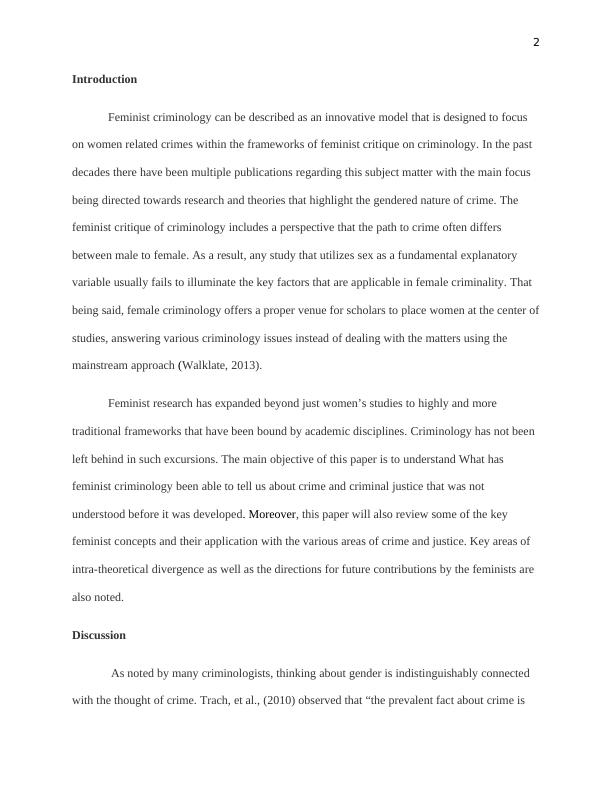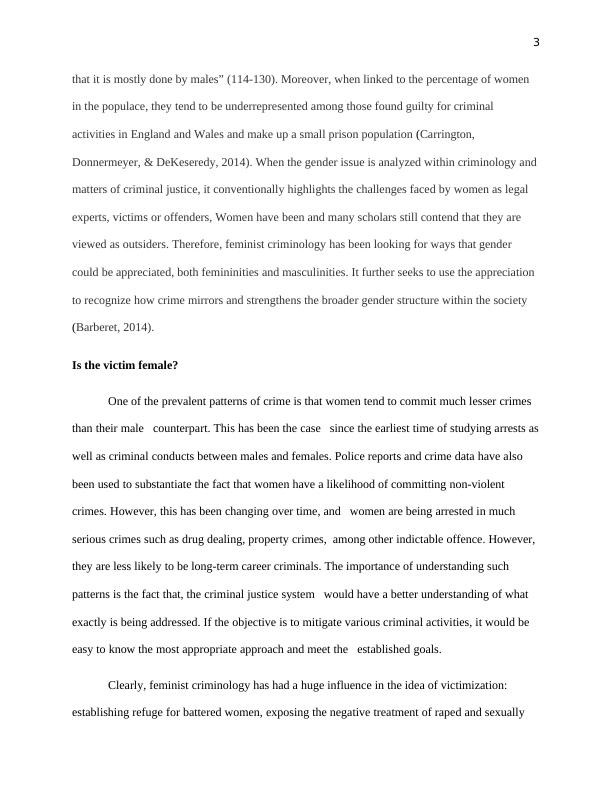Feminist criminology and crime and society
Added on 2022-10-17
15 Pages4228 Words354 Views
1
Crime and Society
Question:
What has feminist criminology been able to tell us about crime and criminal justice that was not
understood before it was developed? How useful is this new information?
Crime and Society
Question:
What has feminist criminology been able to tell us about crime and criminal justice that was not
understood before it was developed? How useful is this new information?

2
Introduction
Feminist criminology can be described as an innovative model that is designed to focus
on women related crimes within the frameworks of feminist critique on criminology. In the past
decades there have been multiple publications regarding this subject matter with the main focus
being directed towards research and theories that highlight the gendered nature of crime. The
feminist critique of criminology includes a perspective that the path to crime often differs
between male to female. As a result, any study that utilizes sex as a fundamental explanatory
variable usually fails to illuminate the key factors that are applicable in female criminality. That
being said, female criminology offers a proper venue for scholars to place women at the center of
studies, answering various criminology issues instead of dealing with the matters using the
mainstream approach (Walklate, 2013).
Feminist research has expanded beyond just women’s studies to highly and more
traditional frameworks that have been bound by academic disciplines. Criminology has not been
left behind in such excursions. The main objective of this paper is to understand What has
feminist criminology been able to tell us about crime and criminal justice that was not
understood before it was developed. Moreover, this paper will also review some of the key
feminist concepts and their application with the various areas of crime and justice. Key areas of
intra-theoretical divergence as well as the directions for future contributions by the feminists are
also noted.
Discussion
As noted by many criminologists, thinking about gender is indistinguishably connected
with the thought of crime. Trach, et al., (2010) observed that “the prevalent fact about crime is
Introduction
Feminist criminology can be described as an innovative model that is designed to focus
on women related crimes within the frameworks of feminist critique on criminology. In the past
decades there have been multiple publications regarding this subject matter with the main focus
being directed towards research and theories that highlight the gendered nature of crime. The
feminist critique of criminology includes a perspective that the path to crime often differs
between male to female. As a result, any study that utilizes sex as a fundamental explanatory
variable usually fails to illuminate the key factors that are applicable in female criminality. That
being said, female criminology offers a proper venue for scholars to place women at the center of
studies, answering various criminology issues instead of dealing with the matters using the
mainstream approach (Walklate, 2013).
Feminist research has expanded beyond just women’s studies to highly and more
traditional frameworks that have been bound by academic disciplines. Criminology has not been
left behind in such excursions. The main objective of this paper is to understand What has
feminist criminology been able to tell us about crime and criminal justice that was not
understood before it was developed. Moreover, this paper will also review some of the key
feminist concepts and their application with the various areas of crime and justice. Key areas of
intra-theoretical divergence as well as the directions for future contributions by the feminists are
also noted.
Discussion
As noted by many criminologists, thinking about gender is indistinguishably connected
with the thought of crime. Trach, et al., (2010) observed that “the prevalent fact about crime is

3
that it is mostly done by males” (114-130). Moreover, when linked to the percentage of women
in the populace, they tend to be underrepresented among those found guilty for criminal
activities in England and Wales and make up a small prison population (Carrington,
Donnermeyer, & DeKeseredy, 2014). When the gender issue is analyzed within criminology and
matters of criminal justice, it conventionally highlights the challenges faced by women as legal
experts, victims or offenders, Women have been and many scholars still contend that they are
viewed as outsiders. Therefore, feminist criminology has been looking for ways that gender
could be appreciated, both femininities and masculinities. It further seeks to use the appreciation
to recognize how crime mirrors and strengthens the broader gender structure within the society
(Barberet, 2014).
Is the victim female?
One of the prevalent patterns of crime is that women tend to commit much lesser crimes
than their male counterpart. This has been the case since the earliest time of studying arrests as
well as criminal conducts between males and females. Police reports and crime data have also
been used to substantiate the fact that women have a likelihood of committing non-violent
crimes. However, this has been changing over time, and women are being arrested in much
serious crimes such as drug dealing, property crimes, among other indictable offence. However,
they are less likely to be long-term career criminals. The importance of understanding such
patterns is the fact that, the criminal justice system would have a better understanding of what
exactly is being addressed. If the objective is to mitigate various criminal activities, it would be
easy to know the most appropriate approach and meet the established goals.
Clearly, feminist criminology has had a huge influence in the idea of victimization:
establishing refuge for battered women, exposing the negative treatment of raped and sexually
that it is mostly done by males” (114-130). Moreover, when linked to the percentage of women
in the populace, they tend to be underrepresented among those found guilty for criminal
activities in England and Wales and make up a small prison population (Carrington,
Donnermeyer, & DeKeseredy, 2014). When the gender issue is analyzed within criminology and
matters of criminal justice, it conventionally highlights the challenges faced by women as legal
experts, victims or offenders, Women have been and many scholars still contend that they are
viewed as outsiders. Therefore, feminist criminology has been looking for ways that gender
could be appreciated, both femininities and masculinities. It further seeks to use the appreciation
to recognize how crime mirrors and strengthens the broader gender structure within the society
(Barberet, 2014).
Is the victim female?
One of the prevalent patterns of crime is that women tend to commit much lesser crimes
than their male counterpart. This has been the case since the earliest time of studying arrests as
well as criminal conducts between males and females. Police reports and crime data have also
been used to substantiate the fact that women have a likelihood of committing non-violent
crimes. However, this has been changing over time, and women are being arrested in much
serious crimes such as drug dealing, property crimes, among other indictable offence. However,
they are less likely to be long-term career criminals. The importance of understanding such
patterns is the fact that, the criminal justice system would have a better understanding of what
exactly is being addressed. If the objective is to mitigate various criminal activities, it would be
easy to know the most appropriate approach and meet the established goals.
Clearly, feminist criminology has had a huge influence in the idea of victimization:
establishing refuge for battered women, exposing the negative treatment of raped and sexually

4
assaulted females at the hands of males as well as within the organizations of justice. Moreover.
the concept of feminist criminology has continued to demonstrate the criminal risks confronted
by females more often at the hands of male counterparts or even relatives (Letts, 2009). The
plans to fight violence against women has influenced the reputation of faceless aggressors. No
doubt, development of criminal justice policies and the acknowledgement of “the victim” had an
influence on the characterization of victims. Roughly, there has developed an idea that the needs
of all victims are met, and those needs are usually characterized as needs that arise from distress
or insufficient unformal support (Parmar, 2017). Women and the elderly are usually the most
targeted factions, though not exclusively in most cases today. The society tends to think of crime
victims as struck by tragedy, and thus attention is often been directed on those who might be
going through violence.
Sharpe, (2013) indicates that victims are usually characterized as those who are less
influential and least justified of various criminal violations (p.35). The emphasis on violence
against females as well as the needs of the ageing tend to amplify the views of the victims as in
need of a lot of help and weak. By making evident the fear of sexual violence as well as its
interconnection with the normal heterosexuality, feminists who focused on women and violence
consciously locates women’s accounts of males’ violence within female gendered experience
(Walsh, 2011). However, most of these criminologists have been accused of gendering violence
by characterizing male violence and women confrontation as an assertion of their (women)
structural susceptibility.
By depicting women as subordinates, the accusation tends to focus on the idea that
women are portrayed as victims. However, does speaking about male rape victims diminish the
conceptualized male violence against women as a gendered experience? Rogers, (2011) argues
assaulted females at the hands of males as well as within the organizations of justice. Moreover.
the concept of feminist criminology has continued to demonstrate the criminal risks confronted
by females more often at the hands of male counterparts or even relatives (Letts, 2009). The
plans to fight violence against women has influenced the reputation of faceless aggressors. No
doubt, development of criminal justice policies and the acknowledgement of “the victim” had an
influence on the characterization of victims. Roughly, there has developed an idea that the needs
of all victims are met, and those needs are usually characterized as needs that arise from distress
or insufficient unformal support (Parmar, 2017). Women and the elderly are usually the most
targeted factions, though not exclusively in most cases today. The society tends to think of crime
victims as struck by tragedy, and thus attention is often been directed on those who might be
going through violence.
Sharpe, (2013) indicates that victims are usually characterized as those who are less
influential and least justified of various criminal violations (p.35). The emphasis on violence
against females as well as the needs of the ageing tend to amplify the views of the victims as in
need of a lot of help and weak. By making evident the fear of sexual violence as well as its
interconnection with the normal heterosexuality, feminists who focused on women and violence
consciously locates women’s accounts of males’ violence within female gendered experience
(Walsh, 2011). However, most of these criminologists have been accused of gendering violence
by characterizing male violence and women confrontation as an assertion of their (women)
structural susceptibility.
By depicting women as subordinates, the accusation tends to focus on the idea that
women are portrayed as victims. However, does speaking about male rape victims diminish the
conceptualized male violence against women as a gendered experience? Rogers, (2011) argues

End of preview
Want to access all the pages? Upload your documents or become a member.
Related Documents
Feminist Perspective on Gender and Crime: A Critical Analysislg...
|10
|2715
|182
Gender and Crime Annotated Bibliographylg...
|5
|989
|406
Feminism and Crime Causationlg...
|9
|2553
|58
General Strain Theory and Social Learning Theory in Criminologylg...
|8
|1408
|94
Why Messerschmidt rejects Jefferson's thesis on a male criminal behaviour analysislg...
|2
|723
|204
Feminist Criminology Assignment - Essaylg...
|7
|1434
|8
